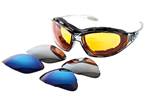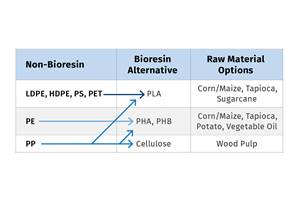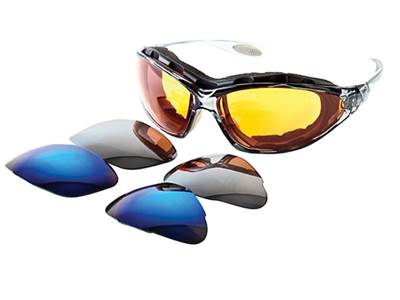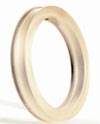Best Practices for Purging PHA and PHA/PLA Blends
Because bioplastics are processed at lower temperatures, purging between jobs requires a different process and purging agents than those applied for traditional resins.

Technical manager Dave Denzel, shown running a purge trial, recommends that if you have a process interruption that will cause more than 15 minutes of downtime while running PLA or PLA/PHA, you would do well to purge with a PLA/PHA purging compound blend. Source: iD Additives
Bioplastics will look to play a significant role in the evolution of the circular plastics economy. Because these materials are processed at lower temperatures, purging injection molding, extrusion or blow molding equipment between bioresin jobs requires a different process and agents than applied for traditional resins.
There are multiple ways to purge low-temperature PLA and PLA/PHA blends, as well as similar biomaterials, from your machines. Generally, you will follow the same practices for both PLA and PLA/PHA blends, regardless of the type of equipment.
Get Off to a Good Start
Depending on the materials that ran before changing to PLA and PLA/PHA, they might require purging at a higher temperature before lowering the temperature back down to process the bioplastics. Typically, in any operation where you are going from any type of low-melt PE to a PLA or PLA/PHA blend, you won’t need to do any purging before you switch over.
That being said, you should transition the temperatures down for PLA or PLA/PHA blends to the desired setpoint while running PE, then start feeding the PLA compound. Begin dropping the temperatures in intervals with a two-to-five-melt-index polyolefin, if available, or choose the correct purge compound that enables you to drop the temperature first to get closer to the lower processing temperatures of PLA and PLA/PHA.
If you run something on a bottle-grade PET line, it gets a little more complicated because the temperature difference between PET and PLA is more dramatic. To purge PET, use a two-to-five-melt-index polyolefin purge compound while shifting temperatures down to a typical PLA or PLA/PHA range. Equipment producing PET typically runs between 572°F and 662°F (300-350°C). The temperature range for PLA is typically between 302°F and 356°F (150-180°C), while a PLA/PHA blend runs between 338°F and 392°F (170-200°C). Running PLA at the temperature levels used for PET would cause fumes and objectionable odors.
A purging compound concentrate can be an aggressive nonabrasive means for removing stubborn degraded resin, colorant and carbon buildup.
While at typical PET temperatures, switch to a two-to-five-melt-index polyolefin purge compound and purge at the typical PET temperature until you are confident the PET is gone. Next, start ramping the temperature down to PLA or PLA/PHA set points. After bringing the temperature down, purge out the polyolefin purge compound with PLA- or PLA/PHA-blended material and move into production with the PLA compound. When the trial is finished, reverse the process. Purge PLA with polyolefin purge compound and ramp temperatures up to typical PET levels. Once you are at the desired temperature, you can start feeding PET.
Choose the Right Purging Compound
When you need to purge, a two-to-five-melt-index polyolefin material mixed with a pellet or a liquid purging compound is a great start. As you get closer to PLA and PLA/PHA temperatures, you can mix the purging compound with the PLA and PLA/PHA materials to finish the purge. When you switch back from PLA and PLA/PHA to a different material, start raising the temperatures and use the polyolefin purging compound until the desired temperature is met.
A highly concentrated, heat-stabilized, nonpolymer-based pellet purging compound concentrate or liquid purging compound concentrate can be used with a wide range of materials and temperatures. This would be suitable to use with low-temperature PLA and PLA/PHA blends, as well as other biomaterials.
Purging compound concentrates usually are designed to melt prior to the thermoplastic resin. Mixed with any material at the proper ratio, they deliver a safe and effective purge. A purging compound concentrate can be an aggressive nonabrasive means for removing stubborn degraded resin, colorant and carbon buildup while reducing the costs associated with the purging process, including downtime, scrap and lost efficiency. When using a purging compound concentrate mixed with your material, that blended material can still be recycled per your guidelines. This also enables you to purge on the fly and make parts if necessary.
If you have a mechanical problem and your line is going to be down for 30 minutes, you need to purge the barrel with a polyolefin purge compound when you start up.
In processes using liquid color, you can feed a liquid purging compound concentrate in the same system at the proper percentage rate for the material being run; you just need to change out the feed tube. In processes using a pellet color feeder, you can use the color feeder and set the proper percentage rate for the purging compound concentrate of the material being purged.
Steps to Follow During and After Purging Biomaterials
Purging and Shutdown:
- Make certain all auxiliary equipment is disconnected.
- Clean the hopper and feed throat.
- Clear the barrel by starving the screw, leaving the barrel free of resin.
- Mix liquid purge concentrate per your purge supplier’s guidelines. With iD Additives’ purge, we recommend mixing at a ratio of 2% (four ounces of liquid purge to 12 pounds of resin) or pellet concentrate at a ratio of 25% (2.5 pounds of pellet purge to 7.5 pounds of resin). Typically, only one barrel’s capacity is required for a normal purge process. Older equipment and more difficult purging applications may require an additional purge cycle.
- Load the purge/resin mixture into the hopper or feed throat and charge the entire barrel.
- Purge continuously through the machine until purge is clean and free of contamination.
- During the process, the purge is experiencing a thermal mixing reaction which is breaking down any color or degraded polymer in the barrel and on the screw.
- Although soaking is not required, it may be necessary for tough purging applications.
- For shutdown, once the barrel is completely clean, charge the entire barrel with the purge mixture. Stop screw rotation and turn off all heaters on the machine.
- A word of caution: Do not rotate the screw while the system is cooling.
Startup After Purging Shutdown
- Turn machine power on and bring the machine to the desired operating temperature.
- Follow any additional startup procedures necessary for the process.
- Once the operating temperature has been reached, slowly rotate the screw. Do not rotate the screw at full speed.
- If the purge coming out of the machine has any contamination, introduce more of the purge mixture and flush the system until thoroughly clean.
- Using the resin required for the next production run, flush any remaining purge.
- Make necessary adjustments to the machine and begin production.
Purging During Equipment Problems
If you have a process interruption while using your PLA or PLA/PHA blend that will cause more than 15 minutes of downtime, you should purge with a PLA/PHA purging compound concentrate blend or at least purge out all the material that sat in the barrel before returning to production. If the shutdown is planned for more than 30 minutes, you should purge with a polyolefin purge compound. This could take place when you are shutting down for lunch, for example.
If you have a mechanical problem and your line is going to be down for 30 minutes, you need to purge the barrel with a polyolefin purge compound when you start up. Do this whether you are switching to or from PLA or PLA/PHA.
ABOUT THE AUTHOR: Dave Denzel is a technical manager at iD Additives Inc., La Grange, Illinois, and earned a bachelor’s degree in technical education with a concentration in plastics. He has more than 40 years of experience in plastics industry management and processes. Denzel assists clients in training, troubleshooting and selecting the proper commercial purge compound for injection molding, extrusion and blow molding. Contact: 708-588-0081 x2888; ddenzel@idadditves.com; idadditives.com.
Related Content
Why Are They Blending Biopolymers?
A sit-down with bioplastic producer Danimer Scientific showed me there are more possible answers to that question than I had previously thought.
Read MoreHow to Optimize Your Molds and Hot Runners for Processing Bioresins
Demand for bioresins is growing in molded goods, particularly as a sustainability play to replace fossil-fuel based materials, but these materials are not a drop-in replacement for traditional materials. Molds and hot runners need to be optimized for these materials.
Read MorePHA Compound Molded into “World’s First” Biodegradable Bottle Closures
Beyond Plastic and partners have created a certified biodegradable PHA compound that can be injection molded into 38-mm closures in a sub 6-second cycle from a multicavity hot runner tool.
Read MoreMaking a Play With PHA
Processors with sustainability goals or mandates have a number of ways to reach their goals. Biopolymers are among them.
Read MoreRead Next
How to Avoid Problems When Using Commercial Purging Compounds
The best approach is to implement and standardize a three-step program to ensure you are purging in the best and most cost-effective manner possible.
Read MoreBetter Purging Saves Money, Material and Time
How much money can a better purging compound save even a small molder?
Read More



















